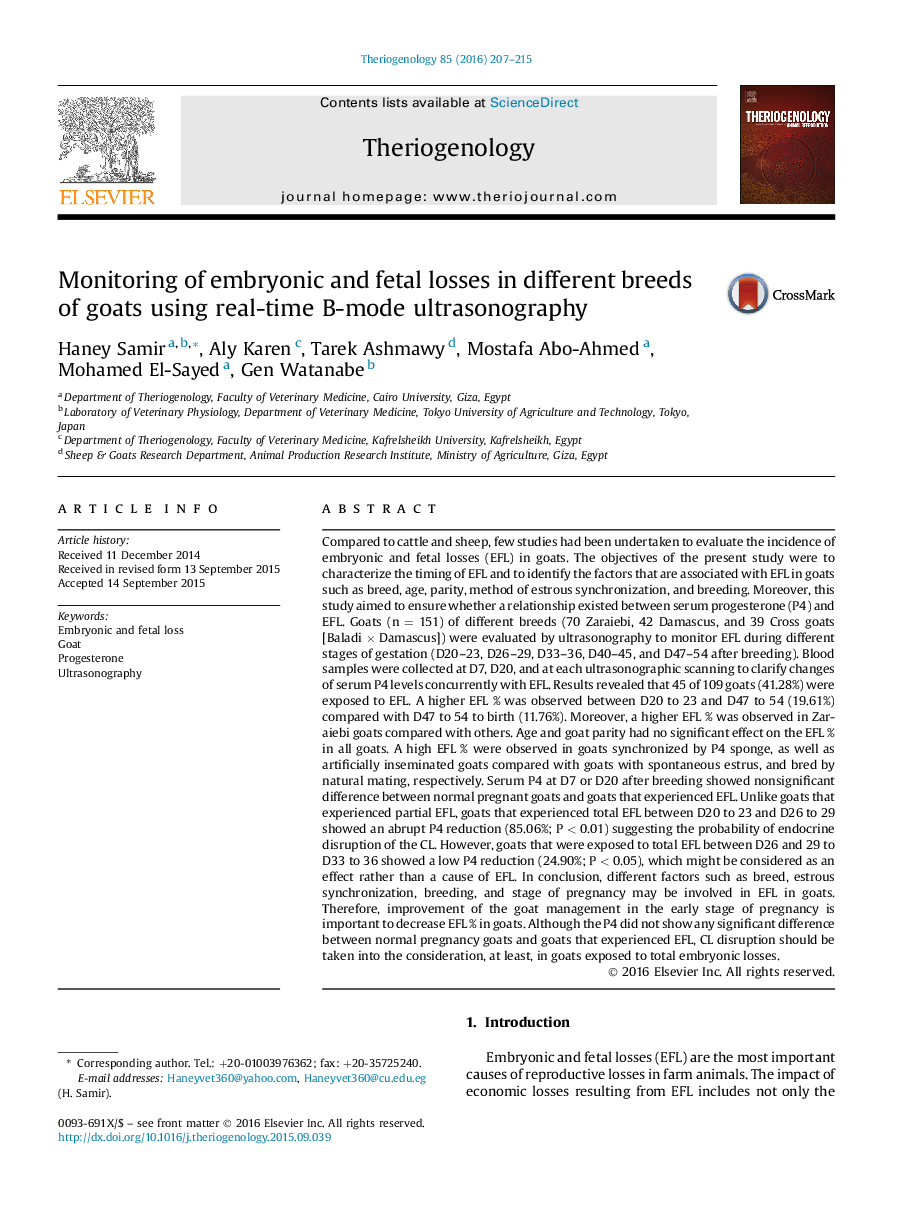| کد مقاله | کد نشریه | سال انتشار | مقاله انگلیسی | نسخه تمام متن |
|---|---|---|---|---|
| 2094839 | 1082055 | 2016 | 9 صفحه PDF | دانلود رایگان |
عنوان انگلیسی مقاله ISI
Monitoring of embryonic and fetal losses in different breeds of goats using real-time B-mode ultrasonography
دانلود مقاله + سفارش ترجمه
دانلود مقاله ISI انگلیسی
رایگان برای ایرانیان
موضوعات مرتبط
علوم زیستی و بیوفناوری
علوم کشاورزی و بیولوژیک
علوم دامی و جانورشناسی
پیش نمایش صفحه اول مقاله

چکیده انگلیسی
Compared to cattle and sheep, few studies had been undertaken to evaluate the incidence of embryonic and fetal losses (EFL) in goats. The objectives of the present study were to characterize the timing of EFL and to identify the factors that are associated with EFL in goats such as breed, age, parity, method of estrous synchronization, and breeding. Moreover, this study aimed to ensure whether a relationship existed between serum progesterone (P4) and EFL. Goats (n = 151) of different breeds (70 Zaraiebi, 42 Damascus, and 39 Cross goats [Baladi Ã Damascus]) were evaluated by ultrasonography to monitor EFL during different stages of gestation (D20-23, D26-29, D33-36, D40-45, and D47-54 after breeding). Blood samples were collected at D7, D20, and at each ultrasonographic scanning to clarify changes of serum P4 levels concurrently with EFL. Results revealed that 45 of 109 goats (41.28%) were exposed to EFL. A higher EFL % was observed between D20 to 23 and D47 to 54 (19.61%) compared with D47 to 54 to birth (11.76%). Moreover, a higher EFL % was observed in Zaraiebi goats compared with others. Age and goat parity had no significant effect on the EFL % in all goats. A high EFL % were observed in goats synchronized by P4 sponge, as well as artificially inseminated goats compared with goats with spontaneous estrus, and bred by natural mating, respectively. Serum P4 at D7 or D20 after breeding showed nonsignificant difference between normal pregnant goats and goats that experienced EFL. Unlike goats that experienced partial EFL, goats that experienced total EFL between D20 to 23 and D26 to 29 showed an abrupt P4 reduction (85.06%; P < 0.01) suggesting the probability of endocrine disruption of the CL. However, goats that were exposed to total EFL between D26 and 29 to D33 to 36 showed a low P4 reduction (24.90%; P < 0.05), which might be considered as an effect rather than a cause of EFL. In conclusion, different factors such as breed, estrous synchronization, breeding, and stage of pregnancy may be involved in EFL in goats. Therefore, improvement of the goat management in the early stage of pregnancy is important to decrease EFL % in goats. Although the P4 did not show any significant difference between normal pregnancy goats and goats that experienced EFL, CL disruption should be taken into the consideration, at least, in goats exposed to total embryonic losses.
ناشر
Database: Elsevier - ScienceDirect (ساینس دایرکت)
Journal: Theriogenology - Volume 85, Issue 2, 15 January 2016, Pages 207-215
Journal: Theriogenology - Volume 85, Issue 2, 15 January 2016, Pages 207-215
نویسندگان
Haney Samir, Aly Karen, Tarek Ashmawy, Mostafa Abo-Ahmed, Mohamed El-Sayed, Gen Watanabe,